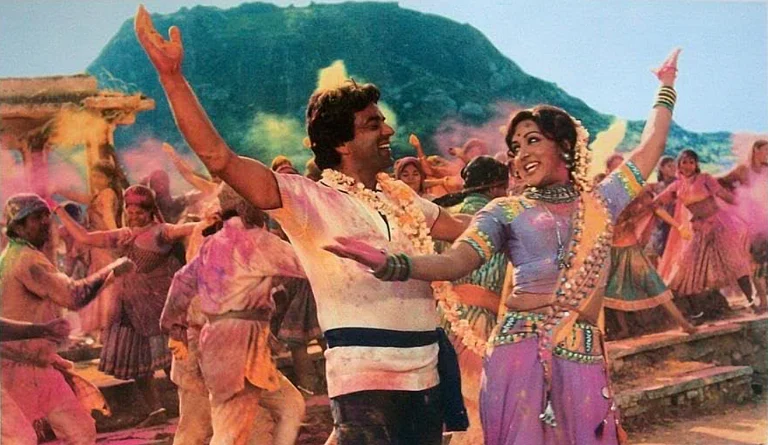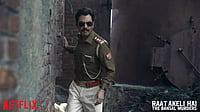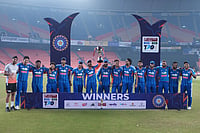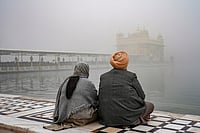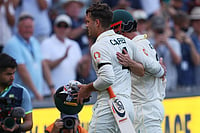
Sholay (1975) marks half a century of cinematic influence.
Its recent 4K re-release in Toronto and Bologna reignites conversations beyond nostalgia, positioning the film as the foundation of Bollywood storytelling.
Jai and Veeru’s friendship transcends the trope of partners-in-crime, setting a benchmark for countless films.
Bollywood has long embraced the “buddy film”, where men with distinct temperaments, quirks and strengths form an unlikely, yet magnetic partnership. Whether as a duo or trio, their camaraderie drives the narrative through solidarity, clashes and spectacular fight sequences that test and deepen their bond. The result is a heady mix of charisma, loyalty and intensity, shaping arcs that both celebrate and interrogate male friendship. Over the decades, these films have mirrored shifting socio-economic backdrops, evolving in style and substance. The genre has evolved decisively, yet the iconic template endures—rightly revered. Sholay celebrates its 50th anniversary this August 15, recently restored in 4K for screenings in Toronto and Bologna. For a film so deeply cherished by Indian cinephiles, its absence from Indian theatres feels like a distant call, a hope that a homecoming re-release is near. Until then, every buddy film carries the unmistakable debt to Sholay and the legendary duo of Jai (Amitabh Bachchan) and Veeru (Dharmendra) without whom the genre itself cannot be recalled.
Sholay is far more than a reimagined Western: its singularity lies in how it builds itself around the bond between Jai and Veeru, not merely as agents of justice but as the very spine of the narrative. The plot is calibrated to chart the contours of their relationship: channeling the intensity of epic duos like Ram and Lakshman or Krishna and Arjun, where loyalty entwines with moral duty. Sholay’s resonance heavily rests upon the friendship and almost homo-romantic devotion between Jai and Veeru; their romantic ties to Basanti (Hema Malini) and Radha (Jaya Bhaduri) serving little purpose beyond preserving heteronormative balance. In Indian storytelling, female camaraderie (or even enmity) is often confined to familial bonds, deployed for fleeting plot points, or diminished to the pursuit of a shared male love interest. One might question why India has lesser women-centric buddy films—as if the absence of dominant male characters automatically renders a plot unsellable. Even in Hollywood, the rise of buddy films in the 1970s was less a celebration of camaraderie than a measured reaction to female empowerment. It pushed women to the sidelines, favouring male alliances that guarded their own space against women’s demands for equality.
Imagine Devdas (2002) ending with Paro (Aishwarya Rai Bachchan) and Chandramukhi (Madhuri Dixit Nene) walking away together, or Silsila (1981) with Chandni (Rekha) and Shobha (Jaya Bachchan) leaving Amit (Amitabh Bachchan) behind. In an ideal world, women recognise their worth, discern the pattern, and refuse to squander their lives chasing men who embody the problem. In recent pop culture memory, a glossy, half-baked attempt at portraying women’s friendships, whether in Veere Di Wedding (2018) or the web-series Four More Shots Please (2019), further alienates the audience from the premise. Contrastingly, a few films like Dedh Ishqiya (2014) and Lipstick Under My Burkha (2016) allow for a more nuanced reading into female camaraderie. Women steer the wheel instead of being ornamental to the plot or reduced to a hero’s love interest. Perhaps the longing is evident for more homegrown films exploring ambition, desire, agency, friendship, intersectionality, and the quiet whispers of everyday life. The vivid memory of watching Thelma & Louise (1991) in action cinema classes lingers, where every moment of rediscovery, rebellion, and redemption is claimed fiercely by the dynamic duo, staking its claim as a “butt-kicking feminist manifesto”.
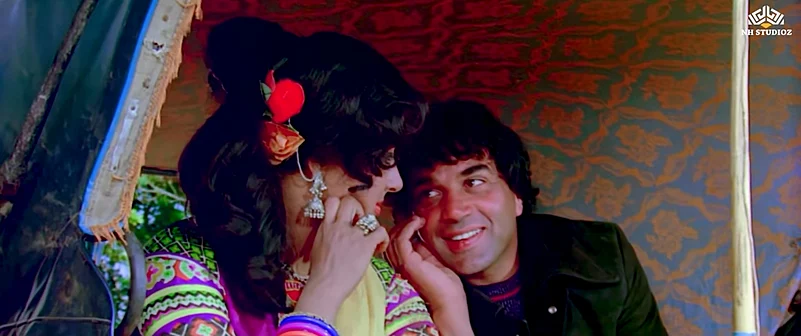
Although traditionally, buddy films have largely revolved around male friendships, they have also offered men a rare sanctuary to explore masculinity, sexuality and an intimacy absent in most heterosexual dynamics. Within these films lies the potential for queer readings, subtle subversions and self-reflection, inviting men to reconsider the depth of their own connections. The not-so-subtle homoerotic undertones between Jai and Veeru unfold, enriching their connection. Their iconic dialogues, brotherhood, mannerisms, and costumes etch themselves into cultural memory, spawning memes, parodies, tributes, and ad film nods. In Karan Arjun (1995), Rakhee’s enduring line “Mere Karan-Arjun aayenge” captures the phenomenon of naming duos in one breath—a gesture that elevates them to the devotional permanence of Heer-Ranjha or Laila-Majnu. Sholay’s Jai-Veeru became the gold standard of cinematic male friendship, shaping the many duos and trios that followed.
Their distinction lies in the unconventional portrayal of their bond. Jai and Veeru embodied Yin and Yang—opposing, yet complementary forces. Veeru’s rural, clever charm clashes yet complements Jai’s polished, urbane self. This contrast broadens the audience’s reach, letting many recognise parts of themselves but also acknowledge the almost mythic scale of their combined courage and integrity. Although, it is reductive to assume that a macho film exists solely for men to identify with. The audience for action is never so neatly divided by gender. Identification is layered and unpredictable; despite testosterone-fueled bravado and hyper-masculine posturing, men do not instinctively always connect with male characters, nor do women with female ones. It hinges on context, on what resonates personally, and on the subtle ways a film mirrors individual experience.
Sholay compels viewers to reconsider male friendship as a terrain where different social hierarchies, temperaments and loyalties are tested and endured. Unlike many buddy films that reduce men to a leader and a sidekick dynamic, Sholay presents them as equals—brimming with vulnerability, dependence and intimacy. Jai-Veeru’s first appearance throws them into the chaos of a train fight, a kinetic introduction that instantly affirms their superb unity under pressure. In the heat of it, Jai and Veeru act in sync—no words, no plan, just an unspoken pact born from knowing each other completely. Even before the central mission is revealed, “Yeh Dosti” becomes a manifesto of their loyalty, declaring a devotion that embraces death before separation. Jai’s reserved nature and calculated seriousness balances Veeru’s spontaneous wit and flamboyance, forging a dynamic where each revealed sides of the other previously unseen. Through Jai’s steady presence, Veeru discovers responsibility and a deeper sense of purpose. Meanwhile, Veeru’s witty humor and zest for life bring lightness to Jai’s life, showing him how joy can persist even in the bleakest moments. The water-tank scene where a drunk Veeru blurts out a proposal casts Jai as an enabler; he doesn’t restrain Veeru’s eccentricities, he readily allows them. This dynamic speaks volumes about the ease with which they tolerate each other’s wildly different impulses. Before the Holi celebrations, their teamwork boasted swagger and thrill, but this time the violence felt personal. Witnessing fellow villagers and Thakur (Sanjeev Kumar) suffer shifted them from merely “showing off“ to discovering a genuine dedication to defend the village.

To find a parallel to this grandeur, only RRR’s Alluri Sitarama Raju (Ram Charan) and Komaram Bheem (N.T. Rama Rao Jr.) come close—their sacrifice, trust, and emotional depth evoke the same Jai-Veeru spirit, scaled to an epic canvas. Bikram and Bala in Gunday (2014) are comparable too—outlaws bound so tightly they share everything—even a love interest. Through a battle of loyalty, fate and circumstances, they eventually reclaim and return to their bond. In hyper-masculine spaces, trust and betrayal are two sides of the same coin, binding the duo’s fate with relentless tension. Jai quite literally manipulates coin tosses in favour of Veeru. Western buddy films often split the duo apart with distrust or conflicts. Sholay refuses to do so—they never turn on each other. They thrive amid lawlessness and brutality, revealing a rare camaraderie forged only in peril. Then come friendships like Aman (Shah Rukh Khan) and Rohit (Saif Ali Khan) in Kal Ho Naa Ho (2003), wherein similarly, relentless banter masks a deep loyalty. Aman’s willingness to surrender the love of his life to Rohit, if it means they live happily—redefines sacrifice. Though the film pivots on a love story, it is the friendship between Aman and Rohit that truly commands attention.
The deviation from the duo has also paved the way for trios and ensemble friendships/brotherhood in films like Dil Chahta Hai (2001), 3 Idiots (2009), Kai Po Che (2013) and Zindagi Na Milegi Dobara (2011). These films move away from the larger-than-life loyalty of Jai-Veeru towards a grounded portrayal of bonds tested by time and circumstance. This allows friends to confront vulnerability, tough conversations, and hidden pain, wherein friendship is both the struggle and the salvation. Across these films, one element remains constant: the everlasting men’s banter. Through laughter and ridicule, a subtle yet genuine warmth and loyalty underlies the storytelling.

Although what makes Sholay evergreen is how it charts the destiny of Jai and Veeru, crystallized in the line “Todenge dum magar, tera saath na chhodenge.” Their pledge transcends life and death, rooting the film in a friendship that is as unshakable as it is mythic. Veeru’s rage and ferocity in the final fight isn’t merely about defeating Gabbar; it is a raw, personal vengeance for Jai. The dynamic flips one last time: the carefree spirit transforms into an unstoppable force, channeling Jai’s memory to claim the triumph. The finale lifts their friendship beyond plot mechanics into mythic resonance: it is no longer merely two men on screen, but an enduring symbol of loyalty, courage, and emotional intensity. By letting this bond dictate the film’s emotional apex, Sholay transforms Jai and Veeru into cinematic icons, establishing a template for male duos whose influence continues to define the contours of Indian cinema.










